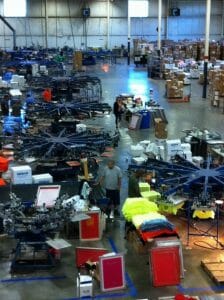
Frustrated with work challenges that involve people? Me too. Don’t you want to just send that jerk-wad a full fledged e-mail rant using all caps to really show them who’s boss? I know you know where the caps lock key is on the keyboard. Time for a left pinky smackdown…
KA-BLAM! UNLEASH THE FREAKING FURY OF THE ALL CAPS RANT!
However, most of our daily work challenges come down to the fact that it’s our own fault.
Huh?
Yes, you. Me too. Ok, stop snickering. I’m serious. It’s all about how your company insists on accountability, empowerment and expectations.
Think about it.
Look Inward Young Man
Maybe your challenges are all internal? There’s that manager in your shop that sits in their office and only judges people by black and white numbers, and isn’t interested in the human element of working. “People smeople”…that attitude just sucks the motivation right out of the room.
What about that sales guy that always dumps some last minute project in your lap with a “Do me a favor!” smile and nervous laugh? You’ll be working on that turd for hours on end trying to make it smell less. Thanks.
Let’s not forget the production manager that shoots off an e-mail about sending the crews home early on Friday, even though they haven’t started that big order that has to ship Monday. That’s when you realize that tuft of hair in your left hand came from your own head. Personally, I don’t have that much to spare.
Is the Customer Always Right?
Did your customer really just send you a “PO” that was handwritten on a napkin? That’s the best they can do?
How about an order request via text message at 11:32 pm at night and expect an immediate response? Those soccer moms can be brutal.
What about “professional” artwork that is created in PowerPoint? …or worse, it’s on the other side of the napkin PO.
Don’t forget about that rush order you spent the weekend producing that’s now been sitting in your pick-up area for eight days; it’s almost mocking you at this point.
What is the Weakest Link in Our Supply Chain?
Of course let’s not forget our supply chain too. Four boxes of youth shirts that you didn’t order is mixed in with your just delivered shipment, but all of your mediums are missing. When you call to get the story they act like it is your fault.
Don’t even get me started about internet providers…
You ordered a part online and the one thing in the box that was shipped is the packing slip. Good thing that came in overnight priority.
Or maybe the only person that knows how to fix your machine has been out to lunch for two hours…all you need is a simple question answered. I guess cell phones don’t work at that Subway.
Let’s not forget the drivers from “big brown” that delivered your shipment to the wrong address for that event…and there’s nothing they can do to correct it without authorization. Ok, you are authorized. Go fix it.
Schadenfreude
Is your head about to explode and make the shrieking sound of a steam freight whistle like in a cartoon? There are thousands of other horror stories that I’ve heard about in this industry. You’ve seen them probably in some Facebook or LinkedIn group. We all like to share our tales of woe.
Schadenfreude at its glorious best.
This type of behavior though isn’t tolerated in other industries and businesses, so why does it always seem to happen in ours? Frankly, I think it’s because to some degree we are scared of our employees. Scared of our customers too, because we need them even more. Scared of taking a stand. Scared of them not coming back. Scared of what they might say. Scared of being flamed on a Twitter post or other social media outlet. Scared that clients are going to take their dollars and spend them with our competition. Scared that our employees are going to go over there too and take all of our “secrets”.
Nobody wants to be the ship that the rats are fleeing from. So nothing get said. This time. That time. Another time. Everything just builds up to the point that there is a hurricane inside that just has to come out.
Unleash the beast!
So before you go full tilt bozo on someone and shoot off that venom laced e-mail, BECAUSE YOU HAVE TO GET THIS PROBLEM OFF YOUR CHEST, take a minute and reflect on how these behaviors happen in the first place.
Why the Blaming Finger Points at You
Internally, what rules do you have in place that set the standards for behavior and workplace expectations? Is it the wild west, where anybody can do anything because there isn’t a written guideline to follow? If you want a different outcome, what do you think needs to happen?
Set some expectations.
Maybe if you had an easy to use online order form on your website (mobile friendly of course), you could direct your customers to use that instead of getting the handwritten napkin or late night text message. Will it stop knuckleheads from doing that completely? Probably not, but it is something you can train these customers to use if they do it the wrong way. “Here Fred, just click this link and follow the order instructions…using this form for order entry is how we help keep your costs down.”
Artwork too. I once had a customer send in a photo of a person wearing a t-shirt with their logo printed on the back as their art for an order as we asked for “camera ready t-shirt art”. My response after the forehead slap? I politely forwarded our branded company art requirements that specified vector art created in Illustrator or saved as a .pdf. We received the correctly formatted file the next day. Sometimes people just don’t comprehend our terminology.
What is second nature to us, is esoteric to everyone else.
One thing to remember is that a good number of our customers don’t understand what we do for a living. We take it for granted as we’re around it constantly. To them though, it’s magic. How many times have you given a guided shop tour and the folks you are walking around are amazed at the wonder of how shirts are decorated? It’s like you are pulling back the curtain in the Wizard of Oz and exposing the darkest secrets. For us, it’s just another day getting orders completed to ship.
Simplify
To that end, if you want a process to proceed correctly, then spend the time and energy setting it up so that there’s only one way to do it. This is our standard. The right way. “Our” way.
How many ways can you order from Amazon? One. Can you call it in? No. Can you send them a PO for ordering? No. Do you have to use their website and follow each prompt along the way? Yes. It’s the only way. They don’t even have a phone number to call for help if you get stuck. They have simplified the process to the point that it is their norm.
Think about your processes in your shop. What are your standards? How many different ways do you have to do something? Having a challenge with a process? What if you made it easier by eliminating all the ways it could possibly go wrong? Simplify the steps. Eliminate the problems by making it impossible to fail.
How can you do that? Easy. Let’s chart out the steps necessary to simplify anything.
First describe your current state. What’s going on? List the things that are good. List the things that are bad. Who is involved and part of the process? Are there time constraints? Write all of this out so it describes the challenge. Be as detailed as you need to be to paint an accurate picture. Here is one example…try writing yours:
“For XYZ Apparel Company, orders from customers are taken in person at the front desk, over the phone, by e-mail, with a purchase order, through our website, and on hand-written order forms. A team of customer service representatives inputs all of the order information into our system, and paper work orders are produced and distributed to the appropriate production group. Most of the orders are entered the same day, but some take a few days to gather all of the information for the order. On average one rep can enter eighteen orders daily; less if there is work quoting jobs or sourcing apparel to purchase for orders. Our average turn time is seven to ten business days. We have a department manager daily production meeting to determine what orders will be worked on each day. Currently we are four business days behind in our production schedule.”
Then write out how you want the process to work. Use the same descriptors as your current state, but describe the Utopian point of view for the process. Write this out so that it describes where you want to go.
“For XYX Apparel Company, orders from customers are downloaded from our website into our production system instantly as they come in. Nobody touches anything. All of the information and artwork is loaded by the customer from our website only, and the system is built to check for accuracy on the front end. Images are handled on the web, and pushed to the appropriate digital production team without the need for human intervention. Orders are automatically queued by ship date, in-stock inventory pulled via smart tablets, and production is processed without paper work orders. Jobs are synced by ship dates, produced, and shipped in three business days or less. The company interacts as a team, and staff is trained to use the system to make decisions. There never is a production meeting, and everyone is accountable and trained to push their work to implement the speed needed for maximum efficiency. “
While this solution may seem far fetched, the goal is write how you want your future to work and then find or create the tools necessary to get there. The question you need to ask yourself is how to bridge the gap between where you are now and where you want to be somewhere in the future?
The important work is to determine how to make that happen.
Do you need software? Different people? More production equipment? More automation? Better training? A new system? Maybe even a better functioning website? New processes and procedures? Maybe even firing a customer or two or dropping a production method altogether to make another area work better? Do you need to bring in someone to help that has the experience championing change?
Make your grocery list of what you need to do to solve your own problems and then gather your resources and execute your idea.
Close the gap between your current frustrated state and the perfect future, by building the bridge between them. Just ask what is wrong now, and what do I need to change?
After all…
IT IS UP TO YOU.
(I can neither confirm nor deny that the title of this blog was inspired by the Tennessee Department of Motor Vehicles.)
“I rant, therefore I am.” – Dennis Miller
“If you could kick the person in the pants that is responsible for most of your trouble, you wouldn’t sit for a month.” – Theodore Roosevelt
“Instant gratification takes too long.” – Carrie Fisher



